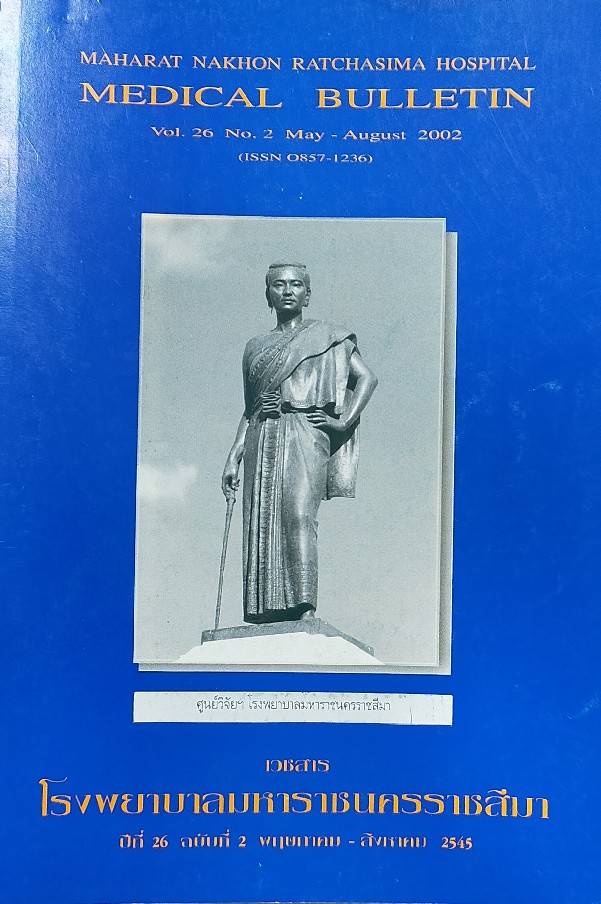การใส่เครื่องกระตุ้นหัวใจห้องล่างขวาชนิดถาวร ที่ศูนย์โรคหัวใจและหลอดเลือด โรงพยาบาลมหาราช นครราชสีมา: ประสบการณ์ 1 ปี
Main Article Content
บทคัดย่อ
บทนำ: การใส่เครื่องกระตุ้นหัวใจห้องล่างขวาชนิดถาวร (permanent cardiac pacemaker, ventricular pacing mode, VVI) ถือเป็นการรักษาสำหรับผู้ป่วยที่มีภาวะหัวใจเต้นช้าและมีอาการจากภาวะดังกล่าว โดยที่สาเหตุของภาวะหัวใจเต้นช้านั้น ไม่สามารถแก้ไขให้หายขาดได้
วัตถุประสงค์: เพื่อรายงานประสบการณ์การใส่เครื่องกระตุ้นหัวใจห้องล่างขวาชนิดถาวร ที่ศูนย์โรคหัวใจและหลอดเลือด กลุ่มงานอายุรกรรม โรงพยาบาลมหาราชนครราชสีมา
ผู้ป่วยและวิธีการ: ผู้ป่วยที่มีอาการจากภาวะหัวใจเต้นช้า (symptomatic bradycardia) ที่มารับการรักษาที่ ศูนย์โรค หัวใจและหลอดเลือด กลุ่มงานอายุรกรรม โรงพยาบาลมหาราชนครราชสีมา ระหว่างวันที่ 1 มิถุนายน 2544 ถึง 31 พฤษภาคม 2545 เป็นระยะเวลา 1 ปี
ผลการศึกษา: มีผู้ป่วยที่มาด้วยอาการของภาวะหัวใจเต้นช้า และได้รับการใส่เครื่องกระตุ้นหัวใจห้องล่างขวาชนิดถาวร จำนวนทั้งหมด 31 ราย เป็นเพศชาย 12 ราย เพศหญิง 19 ราย อายุเฉลี่ย 62.87±14.45 ปี ผู้ป่วยส่วนมากมีอาการเป็นลมหมดสติถึงร้อยละ 50 ที่เหลือมีอาการเหนื่อยไม่มีแรง เวียนศีรษะ แน่นหน้าอก ผู้ป่วยทุกรายได้รับการตรวจคลื่นไฟฟ้าหัวใจ และพบว่ามี third degree atrio-ventricular (AV) block 24 ราย (ร้อยละ 77.4) และ sinus node dysfunction 7 ราย (ร้อยละ 20) ทั้งหมดได้รับการใส่เครื่องกระตุ้นหัวใจห้องล่างขวาชนิดถาวร โดยสอดสายกระตุ้นทางหลอดเลือดดำ subclavian (subclavian venepuncture) โดยไม่มีปัญหาขณะใส่ ค่า lead parameter ขณะใส่คือ ค่า threshold 0.3-0.7 V ค่าเฉลี่ย 0.5 V, impedance 520-1,470 Ohms ค่าเฉลี่ย 827 Ohms, R wave 3.8-27.3 mV ค่าเฉลี่ย 11 mV เมื่อติดตามการรักษาพบว่ามีปัญหาติดเชื้อบริเวณที่ใส่ 1 ราย (3 เดือนหลังใส่) สายกระตุ้นหลุด 1 ราย เกิดขึ้นหลังจากใส่เครื่องไปแล้ว 1 สัปดาห์ ทั้ง 2 รายได้รับการแก้ไขเป็นที่เรียบร้อย
สรุป: การใส่เครื่องกระตุ้นหัวใจห้องล่างขวาชนิดถาวร ถือเป็นการรักษาที่ได้ผลดีในผู้ป่วยที่มีอาการจากภาวะหัวใจ เต้นช้าที่ไม่สามารถแก้ไขสาเหตุได้ และการใส่เครื่องสามารถทำได้ง่ายโดยที่ไม่พบมีภาวะแทรกซ้อนที่รุนแรงเกิดขึ้น
Article Details

อนุญาตภายใต้เงื่อนไข Creative Commons Attribution-NonCommercial-NoDerivatives 4.0 International License.
เอกสารอ้างอิง
Zoll PM. Resuscitation of the heart in ventricular standstill by external electrical stimulation. N Engl J Med 1952; 247:768.
Furman S, Schweidel JB. An intracardiac pacemaker for for Strokes-Adams seizures. N Engl J Med 1959,261:943.
Gregoratos G, Cheitlin MD,Conil A, etal. ACC/AHA guidelines for implantation of cardiac pacemakers and antiarrhythmia devices: a report of the American College of Cardiology American Heart Association Task Force on Practice Guidelines (Committee on Pacemaker Implantation). Am Coll Cardiol 1998;31:1175-209.
Alboni P, Menozzi C, Brignole M, et al. Efts of permanent paceemaker and oral theophylline in sick simus syndrome: The THEOPACE study: a randomized controlled trial. Circulation 1997;9:260-6.
Lamas GA, Pashos CL, Normand SLT, et al. Permanent pacemaker selection and subsequent survival in elderly Medicare pacemaker recipients. Cinculation 1995;91:1063-9.
Myerburg RJ,Kloosterman EM, Castellanos A.Recognition, clinical assessment and management of arrhythmias and conduction disturbances. In: Fuster V, Alexander RW, O'Rourke RA, editors. Hurst's the heart. 10th ed. New York: McGraw-Hill; 2001. p.797-874.
Dhingra RC, Denes P, Wu D, etal. The significant second degree atrioventricular block and bundle branch block: observations regarding site and type of block. Circulation 1976;49:638.
Stamato NJ, O'Toole MF,Enger EL. Permanent pacemaker implantation in the cardiac catheterization labolatory versus the operating room: An analysis of hospital charges and complications. PACE 1992;15:2236-9.
Yamamura KH, Kloostrman EM, Alba J, et al. Analysis of charges and complications of permanent pacemaker implantation in the cardiac caltheterization laboratory versus operating room. PACE 1999;22:1820-4.
Phibbs B, Marriott HJL. Complication of permanent transvenous pacing. N Engl J Med 1985;312:1428.
Mueller X,Sadeghi H,Kappenberger L. Complications after single versus dual chamber pacemakerimplantation. Pacing Clin Electrophysiol 1990;13:711.
Smith TW, Chen I,Epstein LM, Implantable devices for the treatment of cardiac arrbythmia. In: Baim DS, Grossman W,editors. Grossman's cardiac catheterization, angiography, and intervention. 6th ed. Philadelphia: Lippincott Williams & Wilkins; 2000. p. 498-546.


